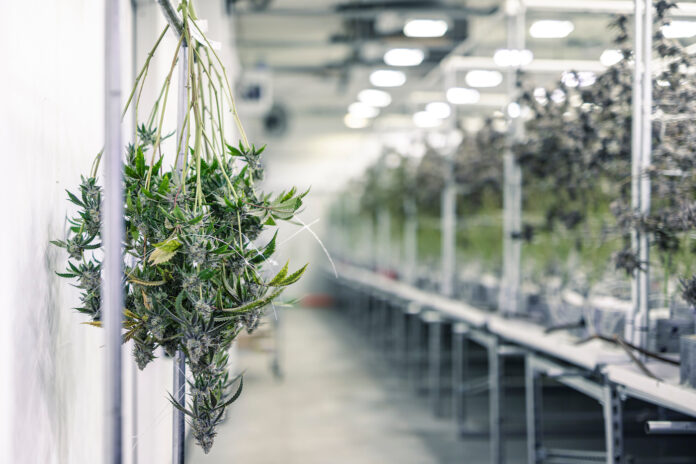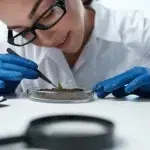Given the financial stakes of indoor cultivators’ operations primarily are rooted in the grow room, adequate biosecurity measures are essential to protect plant investments and harvest profits. Today, safeguarding the integrity of America’s fifth-most-valuable crop requires an intentional and ongoing strategy for defending against threats ranging from fungus gnats to powdery mildew.
Like with many aspects of cultivation, growers have learned through plenty of real-world trials and the occasional error. According to Ron Goldman, founder of HGV Nutrients and vice president of innovation and commercial solutions at Hydrobuilder Holdings, the nation’s second-largest omnichannel platform in hydroponics, there is no substitute or fast track to starting a grow from scratch. “But the guy told me it was clean,” while a common refrain, is small comfort once a pest or pathogen infiltrates a grow room. In most cases, the best choice in such circumstances is to tear everything down and sanitize the building, then start with clean material. “It can be an exercise in futility when you start trying to battle the pest,” said Goldman.
Biosecurity includes practices to protect growing operations from unwanted pests (insects, diseases, rodents, and weeds) as well as ways to prevent transmission. Sometimes referred to as integrated pest management programs, biosecurity programs differ from security in that the threat doesn’t come from people, but rather from pathogens, molds, or pests. Control measures should include evaluating processes in place, reviewing cleaning practices, limiting site access, and managing inputs like growing media.
Once biosecurity and sanitation programs are established, it is important to train employees on the systems and ensure they are followed. The main areas to protect a growing operation include site access, cultivar sourcing, growing media selection, air and water quality, and the human element — basically, anything that could potentially harbor organisms that damage horticultural crops, thereby reducing yield and quality and potentially limiting trade and market access while increasing the cost of production.
Here are six important areas to address as part of your biosecurity program.
The human factor
Take care to minimize the risk that employees will bring in outside threats. Human biosecurity tips include scrubbing and sanitizing shoes before employees enter workspaces, changing clothes upon arrival, donning protective apparel, and frequent handwashing. Human-focused measures also include regular cleaning of facilities and routine maintenance to prevent the growth of weeds near doors.
Specific consideration may need to be made for employees who smoke hand-rolled tobacco cigarettes. Tobacco carries and can spread the tobacco mosaic virus, which is a concern for multiple plant species. It spreads when infected material contacts another plant, such as when someone goes from adding tobacco to a hand-rolled cigarette to working with growing plants.
Begin at the beginning
Source plants and related materials from companies with a known track record in biosecurity. Diseases can spread from plant to plant. Some types of fusarium, other molds, and some plant viruses can be spread by seeds and cuttings from infected plants. Fusarium pathogens can cause root rot, crown rot, chlorotic foliage, and stunted plant growth.
Additionally, some plant strains are showing resistance to important diseases like powdery mildew (Golovinomyces spp.), which causes white, powdery patches on leaves, flowers, and stems and can limit plant growth and reduce flower quality. In addition, some strains are known to be especially susceptible to pathogens including fungi species that damage bud quality post-harvest, making it imperative to know the attributes of strains you grow.
Don’t follow the brewer’s playbook
What plays well in the microbrewery can be dangerous in the grow house. While tours of microbreweries have generated revenue and exposure for master brewers’ operations, opening a grow house up to tours could put the master grower’s business in peril.
Restricting visitor access to a production facility helps minimize the risk of unwanted contaminants entering vehicles, clothing, and shoes. Allowing onsite visitors can increase opportunities for disease introduction and potentially disrupt the growing system. Limiting tours to industry members is not a panacea. Care also should be given to permitting access by delivery vehicles and personnel, who may visit multiple agricultural sites in a day and track contaminants on shoes and tires.
Think grow facility, not swamp
Avoid standing water, know the origin of any water sources, and test regularly for components. Maintaining water quality and preventing water contamination are important elements of protecting a facility.
Pythium species, often called water molds, are problematic pathogens that spread through contaminated water and fertilizer solutions. They can spread rapidly between plants, slowing development and causing roots to take on a brown or rotten appearance. Plants with the disease tend to be small and wilt in warmer temperatures. The pathogen generates water-borne spores and can be spread several ways, including by water, through irrigation systems, and by contaminated growing media, tools, and equipment.
Growing media matters
Contaminated growing media is another potential entry pathway for some diseases and pests. Consider how the processes used to make a medium influence its safety. Knowing the origin of materials can also help avoid unwanted elements in the grow house.
Choosing a medium produced in a controlled environment can protect against harmful organisms in soil. Selecting a material such as mineral wool that has zero contact with water prior to its use in the greenhouse means it will not bring in growing mold or fungi.
A growing medium like coco coir has some natural pest-resistant abilities but also may have been treated with chemicals that can slow plant growth or damage the medium. Any product with a lengthy manufacturing and international shipping process potentially could have more exposure to contaminants.
Mixed potting soil can blend multiple inputs from various sources, raising biosecurity questions. It also may need to be treated with inoculants and biocontrol agents as it is susceptible to pathogen growth and several plant diseases are soil-based.
Choosing a manufacturer with a North American-based production and distribution network can help shorten the supply chain from production to grow room. A growing medium that supports even, predictable water dispersion also helps prevent unwanted water pooling. Selecting a medium that integrates ultraviolet protection into its design can guard against algae growth.
Remember humidity and airflow
Humidity, warm temperatures, and poor circulation can encourage the growth and spread of disease. Improving airflow and maintaining correct humidity levels can reduce this threat. Meanwhile, plants should be monitored for any potential signs of disease. For example, botrytis cinerea, or bud rot, thrives in warm, humid conditions with poor airflow. It can be introduced to a facility in infected plant matter, on tools, or on the clothing of staff or visitors, and it can be a particular concern for cultivars developing large inflorescences with multiple tightly-packed flowers. Several other fungal species that attack post-harvest quality also thrive in the same conditions.
As more markets emerge, taking steps to address the biosecurity of production facilities can help protect growers’ harvests and margins. Awareness of the primary elements of facility biosecurity — people, air quality, moisture, growing media, and plant management — can make production more efficient, consistent, and repeatable going forward.

Tom Blaine serves as business development leader, horticulture, at Owens Corning. He holds a Bachelor of Science in chemical engineering from the University of Toledo and a Master of Business Administration from the University of Michigan Stephen M. Ross School of Business.











[…] mildew. The approach also can aid in pest detection, encouraging cultivators to increase their integrated pest management regimens upon the first sign of unwanted pests prior to […]